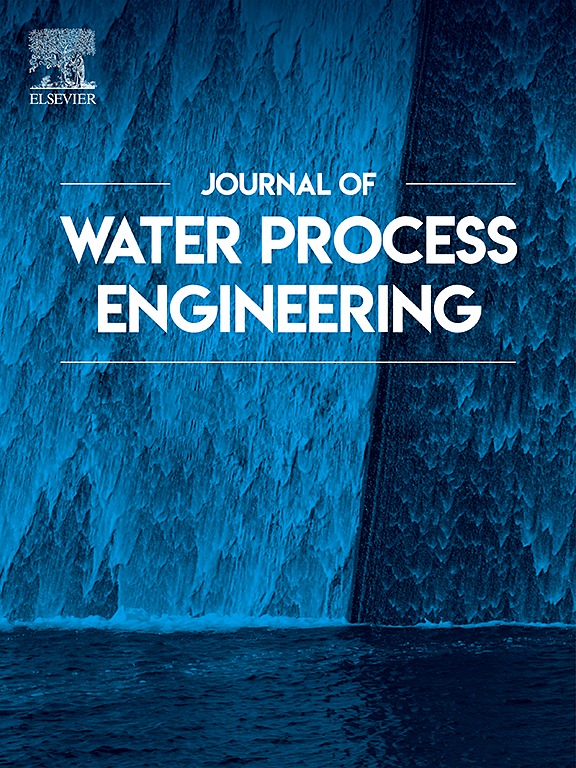Feasibility insights into wastewater phosphorus recovery from plant-wide integrated techno-economic and sustainability modeling analysis
IF 6.3
2区 工程技术
Q1 ENGINEERING, CHEMICAL
引用次数: 0
Abstract
As a crucial strategy to address food security crises and water eutrophication, sludge phosphorus recovery technology has gained increasing attention. However, the plant-wide implementation of phosphorus recovery technologies requires further research. This study systematically evaluated the phosphorus recovery performance of four strategies (Mg dosing, Fe dosing, combined Mg + Fe dosing, and no dosing) through plant-wide modeling enhanced by precipitation dynamics and integrating techno-economic-sustainability analysis. Results demonstrate that metal regulation plays a pivotal role in phosphorus speciation transformation, with the combined Mg + Fe dosing strategy which maximizes recovery potential through complementary mechanisms. The synergistic recovery of struvite and vivianite achieved a phosphorus recovery rate of 28.82 %, minimum effluent phosphorus concentration of 0.74 mg/L, energy consumption of 0.30 kWh/m3, while maintaining methane production at 0.92 kWh/m3. Sustainability analysis revealed that the combined Mg + Fe dosing strategy generated environmental benefits valued at 1.1 yuan/m3, though challenges remain to be addressed regarding the high cost of iron reagents. Plant-wide techno-economic evaluation demonstrated that multi-form phosphorus co-recovery strategy effectively reduces environmental footprint and enhances resource cycling efficiency. These findings establish a decision-support framework for implementing phosphorus recovery technologies in wastewater treatment plants, offering critical insights for promoting circular economy development and scaling up engineering applications of phosphorus recovery technologies.
Synopsis
Wastewater phosphorus recovery should pillar circular economy. This study demonstrated synchronous recovery of struvite and vivianite, highlighting sustainability and techno-economic feasibility, with environmental benefits as key driver for advancing resource recovery policies.
从全厂综合技术经济和可持续性模型分析中对废水磷回收的可行性见解
污泥磷回收技术作为应对粮食安全危机和水体富营养化的一项重要战略,越来越受到人们的重视。然而,磷回收技术的全厂实施需要进一步的研究。本研究通过基于降水动力学的全厂模拟和综合技术经济可持续性分析,系统评估了四种策略(Mg加药、Fe加药、Mg + Fe联合加药和不加药)的磷回收性能。结果表明,金属调控在磷形态转化中起着关键作用,Mg + Fe组合给药策略通过互补机制最大化回收潜力。鸟粪石与活石协同回收,磷回收率为28.82%,出水磷最低浓度为0.74 mg/L,能耗为0.30 kWh/m3,同时甲烷产量保持在0.92 kWh/m3。可持续性分析显示,Mg + Fe组合剂量策略产生的环境效益价值为1.1元/立方米,尽管铁试剂的高成本问题仍有待解决。全厂技术经济评价表明,多形态磷共回收策略有效地减少了环境足迹,提高了资源循环效率。这些发现为污水处理厂实施磷回收技术建立了决策支持框架,为促进循环经济发展和扩大磷回收技术的工程应用提供了重要见解。废水磷回收应成为循环经济的支柱。该研究展示了鸟粪石和活石的同步回收,突出了可持续性和技术经济可行性,环境效益是推进资源回收政策的关键驱动因素。
本文章由计算机程序翻译,如有差异,请以英文原文为准。
求助全文
约1分钟内获得全文
求助全文
来源期刊

Journal of water process engineering
Biochemistry, Genetics and Molecular Biology-Biotechnology
CiteScore
10.70
自引率
8.60%
发文量
846
审稿时长
24 days
期刊介绍:
The Journal of Water Process Engineering aims to publish refereed, high-quality research papers with significant novelty and impact in all areas of the engineering of water and wastewater processing . Papers on advanced and novel treatment processes and technologies are particularly welcome. The Journal considers papers in areas such as nanotechnology and biotechnology applications in water, novel oxidation and separation processes, membrane processes (except those for desalination) , catalytic processes for the removal of water contaminants, sustainable processes, water reuse and recycling, water use and wastewater minimization, integrated/hybrid technology, process modeling of water treatment and novel treatment processes. Submissions on the subject of adsorbents, including standard measurements of adsorption kinetics and equilibrium will only be considered if there is a genuine case for novelty and contribution, for example highly novel, sustainable adsorbents and their use: papers on activated carbon-type materials derived from natural matter, or surfactant-modified clays and related minerals, would not fulfil this criterion. The Journal particularly welcomes contributions involving environmentally, economically and socially sustainable technology for water treatment, including those which are energy-efficient, with minimal or no chemical consumption, and capable of water recycling and reuse that minimizes the direct disposal of wastewater to the aquatic environment. Papers that describe novel ideas for solving issues related to water quality and availability are also welcome, as are those that show the transfer of techniques from other disciplines. The Journal will consider papers dealing with processes for various water matrices including drinking water (except desalination), domestic, urban and industrial wastewaters, in addition to their residues. It is expected that the journal will be of particular relevance to chemical and process engineers working in the field. The Journal welcomes Full Text papers, Short Communications, State-of-the-Art Reviews and Letters to Editors and Case Studies
 求助内容:
求助内容: 应助结果提醒方式:
应助结果提醒方式:


